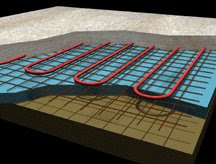Summary: Floor radiant heat can provide a high degree of comfort while saving energy.
Radiant heat from the floor is probably the most comfortable form of home heating you will ever experience.
Other types of heating such as forced air, radiators, and even radiant wall heating or ceiling radiant heating produce hot spots and cold spots in a room. They also require a higher degree temperature of output to heat a room thereby using more energy than floor radiant heat.
Radiant floor temperatures are kept significantly lower than other types of heat. Since there are no hot or cold spots, a comfortable room temperature is easier to achieve and far easier to maintain.
Radiant heated floors can be heated by hot water, electric resistance elements, or hot air.
Hot water and electric are the most common forms of heated floors and of those two, water is usually the least expensive to operate and the most energy efficient.
Water can be heated in any number of ways, including the use of solar energy, and once water is heated, it will hold that heat due to its own mass. This results in an easier to maintain, even temperature.
Electric elements are the least expensive to buy and install, but are the most expensive to operate.
Energy costs, the availability of gas, electric or solar, initial product costs, product installation cost, and the size of your home will all be factors to consider in deciding what radiant heating system is best for your needs.
The only drawback to any type of radiant heating, as I see it, is that if you desire air conditioning, it must be added as a separate system altogether.

Radiant Heating Concrete Slab (Courtesy, Radiant Panel Association)
For more information on Radiant Heating, including finding members and contractors, visit the [Radiant Panel Association](http://www.iapmo.org).
Carl Heldmann


